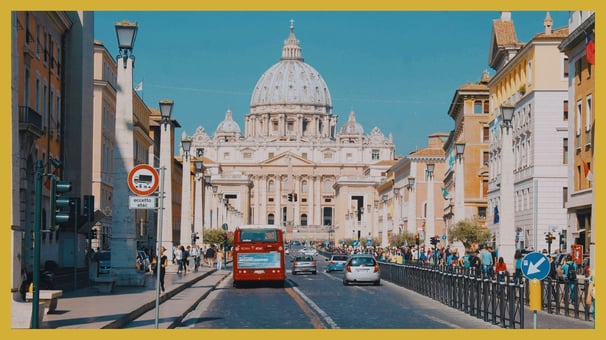Travel and Transport for Pilgrims during the Rome 2025 Jubilee
Contents
Public Transportation in Rome
Airport Connections
Transport Options for Pilgrims
Safety and Mobility
Accessibility for Pilgrims with Disabilities
Taxi and Vehicle Rental
Walking in Rome
Conclusion
The 2025 Jubilee is set to draw millions of pilgrims from across the globe, positioning Rome as the focal point for myriad religious events and celebrations. Ensuring a peaceful and well-organized visit requires knowledge of the transport options and available means of transportation for pilgrims in this historic and bustling city. Though navigating Rome may seem daunting, effective planning can facilitate smooth travel between significant sites. This article offers essential information and practical tips to help pilgrims navigate the vast array of transportation options, ensuring a safe and stress-free pilgrimage experience


Public Transportation in Rome
Rome's public transportation network, consisting of buses, trams, metros, and regional trains, will undergo significant expansion in preparation for the 2025 Jubilee to accommodate the increased influx of pilgrims. The public transport services will be enhanced, featuring extended operating hours, increased frequencies, and new special routes that lead directly to major places of worship and Jubilee Basilicas.
Metro: Rome's Metro system includes three main lines: A (red), B (blue), and C (green). Stations nearest to St. Peter’s Square, Ottaviano and Cipro, are located on Line A. For access to other Jubilee Basilicas such as St. John Lateran, pilgrims should use the San Giovanni station on the same line, which also connects to the Basilica of Santa Maria Maggiore. To visit the Basilica of St. Paul Outside the Walls, the appropriate station is Basilica San Paolo on Line B. Throughout the Jubilee, the Metro will operate with increased frequency and additional services, particularly during major religious celebrations, to ease access to these sacred sites.
Buses e trams: Rome boasts an extensive bus and tram network that connects the city center, suburbs, and primary attractions. These lines will be strengthened to ensure greater service regularity, complemented by special shuttle services tailored for pilgrims. Pilgrims are advised to consult the updated bus routes on ATAC's official website, the entity responsible for public transport in Rome. To optimize travel costs and convenience, pilgrims may purchase daily or weekly tickets that allow unlimited travel and are an economical and practical solution for commuting between places of interest.
Regional trains: Regional trains operated by Trenitalia connect Rome with the surrounding cities and airports. Rome Termini Central Station is the principal railway hub from which numerous regional trains depart. These trains are viable options for pilgrims to reach different destinations or airports. For timetables and ticket purchases, please visit the official Trenitalia website. During the Jubilee, Trenitalia will boost the number of trains to ease travel between Rome and nearby cities, thus facilitating access for pilgrims residing outside the city.
Airport Connections
Rome is accessible via two primary airports: Fiumicino (Leonardo da Vinci) and Ciampino. Both airports provide several transit options to the city center, crafted to ensure a seamless transition for international pilgrims.
From Fiumicino: The Leonardo Express train offers a direct connection to Rome Termini Station in about 30 minutes, with departures every 15 minutes. This service provides a swift and dependable route for attendees of the Jubilee. Alternatively, shuttle buses with variable travel times and official taxis are also available outside the arrivals.
From Ciampino: The most direct route to Rome from Ciampino Airport is via shuttle buses, reaching Termini Station in approximately 40 minutes. This service will be intensified during the Jubilee to accommodate the larger influx of visitors, with taxi and NCC (Noleggio Con Conducente, rental with driver services) also available for added convenience.
Transport Options for Pilgrims
Pilgrims planning to visit key worship sites such as St. Peter's, St. John Lateran, and other jubilee basilicas are advised to utilize public transportation and pilgrim-specific transit services. Traffic and parking in Rome can be challenging, particularly during the Jubilee. Public transport provides a way to bypass traffic and reach major sites conveniently.
ATAC provides various ticket and pass options, ideal for pilgrims intending to visit multiple sacred sites swiftly and without the hassle of ticket availability:
Roma 24H: Costs €7.00 - Allows unlimited travel on public transport for 24 hours.
Roma 48H: Costs €12.50 - Allows unlimited travel on public transport for 48 hours.
Roma 72H: Costs €18.00 - Allows unlimited travel on public transport for 72 hours.
Integrated Time Ticket (BIT): Costs €1.50 - Valid for 100 minutes from the first validation, usable across multiple metro lines for one journey.
Tickets are available at authorized outlets, metro stations, or directly from official apps like the ATAC app, which provides convenient access to tickets
Connections Between the Jubilee Churches: Traveling between the main churches, such as St. Peter's, St. John Lateran, St. Mary Major, and St. Paul Outside the Walls, is facilitated by bus and subway lines. Additionally, dedicated shuttle services will be available during the Jubilee to ease travel between these churches, ensuring pilgrims a smooth and hassle-free experience. The article Jubilee Pilgrimages in Rome provides a detailed guide on the most frequented pilgrimage routes, with practical tips on how to plan your movements
Safety and Mobility
Rome is a safe city, however, during mass events like the jubilee celebrations in St. Peter's Square, it is important to take some precautions. These include avoiding crowded areas and keeping valuables in closed bags. Additionally, carrying only essentials and using backpacks or bags with safety zippers to prevent theft is advisable. The article Safety and Travel offers practical safety tips and travel advice for navigating crowded events safely. Furthermore, Rome has established pedestrian zones and protected pathways to aid the mobility of pilgrims and minimize vehicular traffic in densely populated areas. These routes not only ensure greater safety but also facilitate easier walking, especially near the Jubilee churches
Accessibility for Pilgrims with Disabilities
Rome is dedicated to making all its transport means accessible, aiming to enable all pilgrims to participate in the Jubilee events. Most subway and bus stations have ramps, elevators, and other aids to assist those with disabilities. During the Jubilee, volunteers and dedicated staff will be on hand to assist those with mobility challenges, ensuring full participation in the events and celebrations. Pilgrims requiring special assistance should plan their visits in advance and can find more information about available services and facilities on the official website.
For more information, refer to our article on Accessibility for the Disabled.
Taxis and Vehicle Rental
For those who prefer to travel by taxi, Rome boasts a large fleet of vehicles. It is important to use only official taxis, recognizable by their white signs and visible license numbers. Taxis are readily available at major squares and train stations, yet booking in advance during the Jubilee is recommended to avoid long waits. Chauffeured vehicle rental (known locally as NCC - 'Noleggio con Conducente') offers a more personalized transport option, allowing bookings tailored to individual needs and facilitating more comfortable travel between various points of interest.
For pilgrims who prefer to rent a car, it is important to remember that Roman traffic can be intense, especially in central areas. It is recommended to gain prior knowledge about Limited Traffic Zones (ZTLs), especially near the main jubilee basilicas and tourist areas. ZTLs are zones where vehicle access is restricted to specific hours or reserved for residents and authorized vehicles. Failing to adhere to these restrictions can lead to significant fines, so it is important to carefully plan movements and check if your accommodation is located within one of these zones. Furthermore, it is advisable to park in the outskirts and then proceed by public transport or on foot to reach religious sites. Alternatively, using car-sharing services can offer a more flexible way to move around without the concern of parking or ZTLs.
Walking in Rome
Rome is exceptionally suited to being explored on foot, thanks to its compact layout and the close proximity of many of its main monuments. For pilgrims eager to enjoy a walk, the Seven Churches Pilgrimage, known locally as Cammino delle Sette Chiese, offers a unique opportunity to delve into the history and spirituality of the city. Walking through the streets of Rome allows one to discover hidden corners and appreciate the beauty of its historic buildings and churches. Additionally, many of the jubilee basilicas are a short distance from each other, making walking a practical and thrilling choice for those who wish to experience the Jubilee authentically. It is advisable to wear comfortable shoes and carry a map, water, and a light snack to enhance the walking experience.
Conclusion
Transportation in Rome during the 2025 Jubilee will be enhanced to cope with the influx of pilgrims and ensure smooth travel between sacred sites and principal attractions. Planning in advance and informing oneself about public transportation options, taxis, and pedestrian routes is crucial for a serene and safe experience. Regular consulting of the ATAC website for updates on transportation will be of great benefit to all pilgrims. Additionally, leveraging apps like ATAC's official app provides up-to-date information on public transport routes and schedules, simplifying travel planning and ensuring a seamless visit without any hitches
Drop us a line
Follow us
Discover the Jubilee
Experience the Jubilee
Jubilee locations
Get ready for the Jubilee
Rome and the Jubilee
